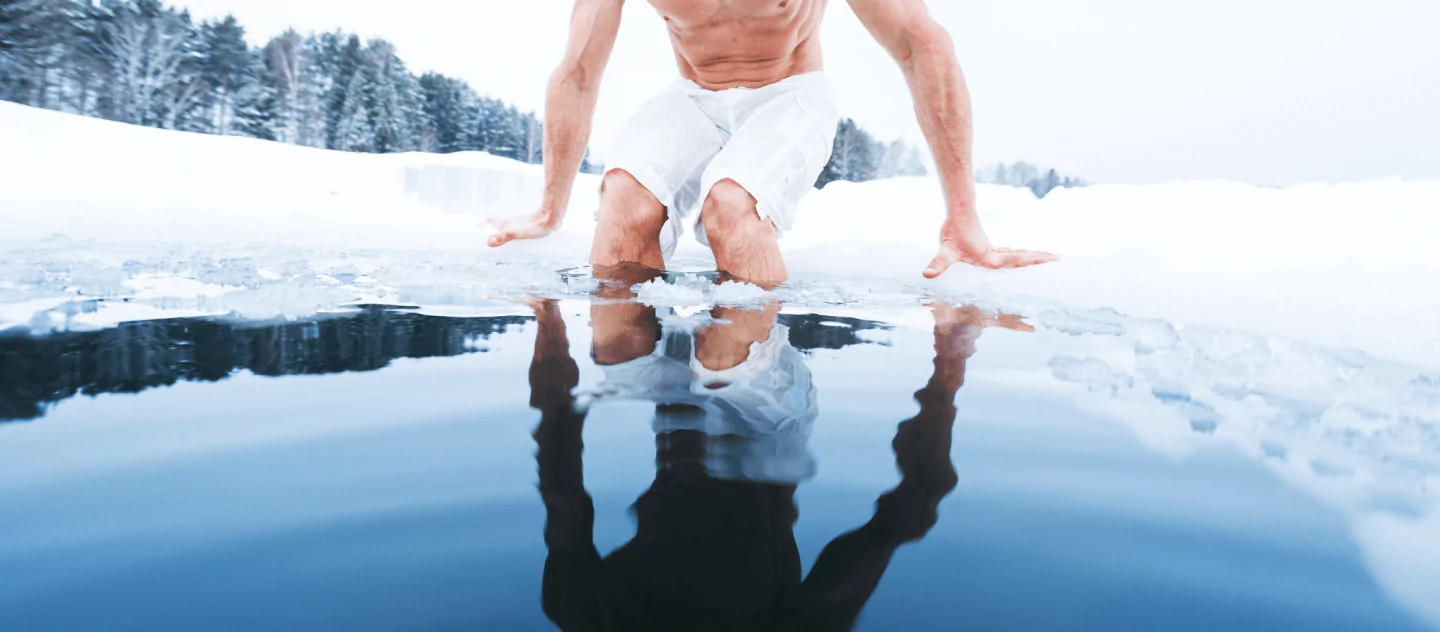Introduction:
Ice Baths are a great way to improve your overall health and wellbeing, although many people are not informed about the benefits of ice baths, and how to use them. If you’re one of those people, don’t worry! This post is a simplified guide to how you can begin your ice bath journey. We’ll cover the science behind using ice baths, the advantages it provides, and the best practices to optimise your experience.
What do Ice Baths do?
Ice baths are insulated tubs forged from PVC, aluminium or cedar wood that holds water whilst maintaining its temperature. They are designed to keep water cold – ice cold and encourage users to engage with cold water therapy. Cold water therapy is the principle of immersing your body in water at temperatures of 15 degrees Celsius and below. Ice baths are more than tubs of water: it’s not just about braving the cold but using a specially insulated body of cold water to reap numerous scientifically backed health benefits.

What’s the benefits of an ice bath?
There are several benefits behind the ice bath. For a more detailed article explaining the science behind these benefits, then check out this blog post about the academic research on the benefits of ice baths.
- Improved Recovery: Ice baths promote and encourage the body’s increased blood flow to muscles. When used after exercising, this can minimise the inflammation of your muscles and reduce soreness.
- Mental Wellbeing: Cold plunges stimulate the release and create an influx of endorphins and neurotransmitters, leading to increased feelings of pleasure and wellbeing. They also create stress-responses as your body is shocked with the cold, helping individuals to develop mental resilience.
- Pain relief: Cold water slows down the nerve speeds of your body, minimising the volume of pain signals that get sent to the brain.
- Quality Rest: A lower body temperature through ice baths results in users falling asleep quicker and with less movement and fidgeting, resulting in a higher amount of quality deep sleep.
- Fat loss: Cold water immersion initiates a body process called Thermogenesis. This process converts white fat cells into brown fat cells, which are much easier to burn off.
(Esperland et al, 2022)
How to Prepare for an Ice Bath?
The first step to jumping into your ice bath is to find a suitable location. Ideally it should be a spot that water is easy to fill and drain from – consider your back garden. Garden hoses can make the process much less labour and time intensive.
When you have your location, make sure you have the right amount of ice to get to the right temperature. If you’re looking for the ultimate hands and hassle-free experience, consider an ice bath chiller, which keeps the water at the right temperature without needing any actual ice.
With all the prerequisites ready, it’s time to begin unpacking. The poles should be placed into their sockets along the side of the bath. Double check that all plugs and taps are sealed to prevent any leaks. The end pipe should be secured to the pump, allowing you to inflate the bath. When its inflated, simply reinsert the plug, fill it with water and ice, and then jump in!
Check out this quick and Easy Guide!
How Cold Should an Ice Bath be?
For most people, water temperatures within the range of 11-15 degrees Celsius are discomforting and cold enough to provide benefits. This range is suitable for cold water therapy, according to acclaimed neuroscientist Andrew Huberman. For those suffering from chronic pain conditions, whole body cryotherapy at temperatures between -5 to -160 degrees Celsius have been shown to be effective at slowing nerve conduction and reducing pain signals to the brain (Garcia et al, 2021). Whereas temperatures of 11-15 degrees are most effective for reducing pain caused by muscle soreness post workout (Machado et al, 2016). Also, studies suggest that temperatures between 4-10 degrees Celsius may yield greater fat loss. Water within this range can lead to more shivering, triggering the release of succinate, a metabolite which further activates brown fat cell thermogenesis.
The key thing to remember is to start slow. Listen to your body and get a feel for the right temperature for you. The more familiar you become with ice baths, the more you can begin to experiment with reducing the temperature. Safety should always come first.
How Long Should you stay in an Ice Bath?
The time spent in an ice bath can vary according to different goals. For optimal recovery, I recommend 10-15 minute sessions at a range of 10-15 degrees Celsius. Longer periods have been shown to potentially aid fat loss as it leads to prolonged brown fat tissue activation resulting in greater caloric expenditure. Alternatively experts like Huberman and Doctor Susanna Søberg recommend a total of 11 minutes per week, spread over 3-4 sessions as the minimum duration for those looking for more manageable times and generalised health benefits. Regardless of your specific goals, scientific studies vouch for total body immersion in your sessions for maximum impact.
Ice Bath Tips for Beginners:
Advice from the British Medical Journal is to begin by easing yourself into the water gradually. Start with 15 degrees Celsius for a short duration, and let your body get accustomed to the feeling. As always, listen to your body, and let it educate you on when its ready for a colder/longer experience.
When stepping out of the bath, it’s important to get to a warmer environment, put on some warm (and dry) clothes, and hydrate yourself well. Making sure that these three things are available is essential to recovery.
To enhance your ice bath experience, you could try deep breathing exercises, to help regulate your body and calm your mind. You might also want to listen to some soothing music, which can further help you relax.
Are Ice Baths Dangerous for you?
Those under 18 and those with certain health conditions should avoid ice baths to avoid risk of injury.
Avoid the ice bath if:
- You’re pregnant, under 18, have circulatory issues or issues with blood pressure, have a heart condition or pacemaker, have Raynaud’s disease, have a history of frostbite, have diabetes, epilepsy, neuropathy, or any open wounds or recent surgeries.
- If you are unsure, then always consult your physician for advice.
- Ready to take the dive into the health-boosting word of ice baths? Then take the Cold Plunge today!
Thanks for all your interest in ice baths!
All the best,
Conor Sheehan (Director of Optizens)
Reference List:
- Esperland, D., de Weerd, L., & Mercer, J. B. (2022). Health effects of voluntary exposure to cold water – a continuing subject of debate. International journal of circumpolar health, 81(1),
- Topic- Metabolism, insulin sensitivity, systematic review https://doi.org/10.1080/22423982.2022.2111789
- Garcia, C., Karri, J., Zacharias, N. A., & Abd-Elsayed, A. (2021). Use of Cryotherapy for Managing Chronic Pain: An Evidence-Based Narrative. Pain and therapy, 10(1), 81–100.https://doi.org/10.1007/s40122-020-00225-w
- Machado, A. F., Ferreira, P. H., Micheletti, J. K., de Almeida, A. C., Lemes, Í. R., Vanderlei, F. M., Netto Junior, J., & Pastre, C. M. (2016). Can Water Temperature and Immersion Time Influence the Effect of Cold-Water Immersion on Muscle Soreness? A Systematic Review and Meta-Analysis. Sports medicine (Auckland, N.Z.), 46(4), 503–514.https://doi.org/10.1007/s40279-015-0431-7
- Tipton, M., Massey, H., Mayhew, A., & Morgan, P. (2022). Cold water therapies: minimising risks. British journal of sports medicine, 56(23), 1332–1334.https://doi.org/10.1136/bjsports-2022-105953
FAQs:
An ice bath is an insulated tub made from PVC, aluminium or cedar wood. This insulation will allow you to experience cold water therapy by maintaining temperatures below 15 degrees Celsius for up to 2 weeks without having to change the water.
Generally, it is recommended that people experience ice baths ranging between 11-15 degrees Celsius. However, this can vary depending on your goals with a temperature of below 10 degrees being recommended for those who use it for pain relief. It is essential when using an ice bath to experience cold water therapy you should always ensure you are experiencing some discomfort.
It is generally recommended that you spend 11 minutes in total a week in an ice bath split over 3-4 sessions as stated by Andrew Huberman. However, this can vary depending on your goals with longer periods being associated with being more beneficial for recovery. What’s most important when using an ice bath is that you are in it for long enough that it is uncomfortable.
The key benefits for using an ice bath are it boosts recovery, helps relieve pain, aids fat loss, gives you a euphoric feeling, increases your resilience to stress and improves your quality of sleep.
There is no research recommending a specific time of the day to have an ice bath. However, based on your goals it may be best to have an ice bath at a specific time. For example, if you want to feel awake, alert, and ready for the day ahead it would be best to have an ice bath in the morning but if you are looking to recover after a workout post exercise would be the best time.
